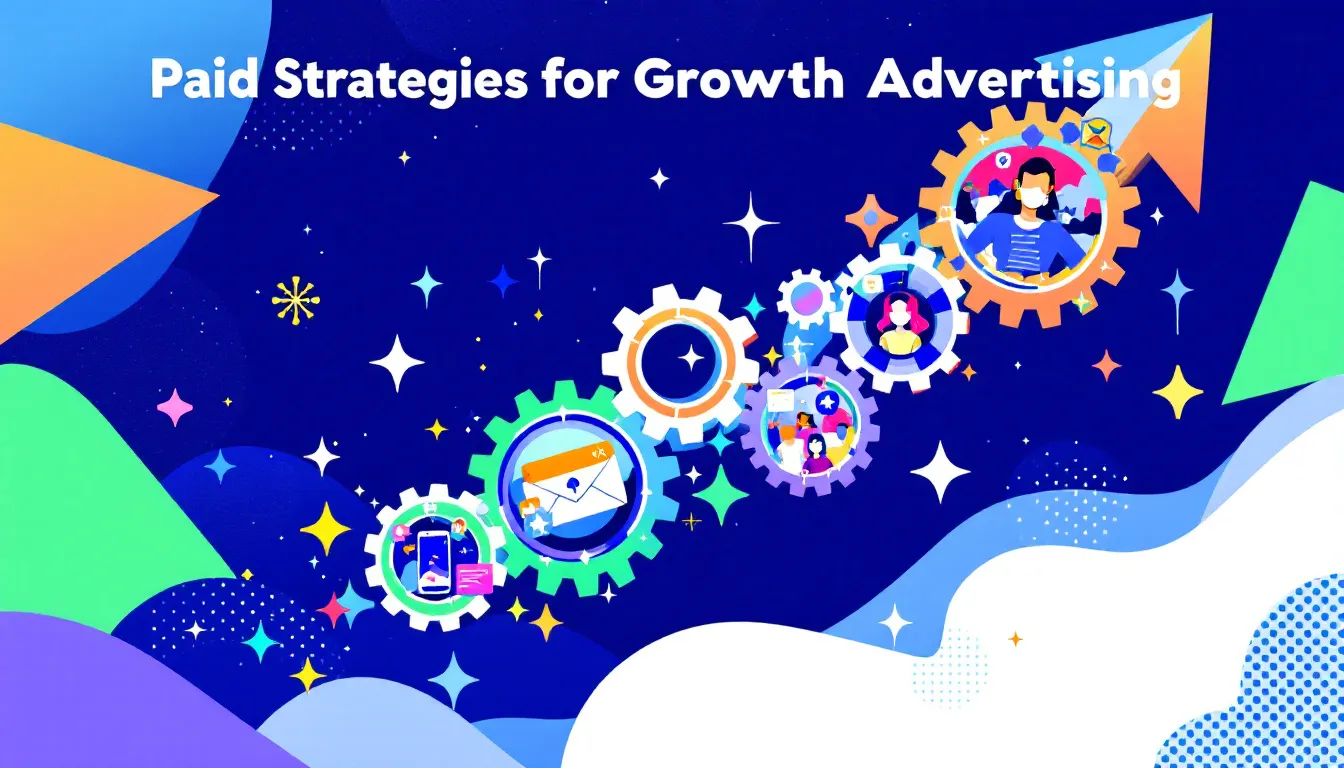Growth advertising focuses on using data to attract, engage, and retain customers throughout their entire journey. Unlike traditional marketing, it’s about driving sustainable growth, not just short-term wins. This article will explore the key components, strategies, and successful examples of growth advertising.
Key Takeaways
- Growth advertising focuses on optimizing the entire customer lifecycle through data-driven strategies, unlike traditional marketing which primarily targets acquisition.
- Key components of a successful growth advertising strategy include understanding the target audience, maintaining a multi-channel approach, and engaging in continuous experimentation.
- Measuring success in growth advertising relies on key performance indicators (KPIs) and customer feedback to inform strategy adjustments and enhance overall effectiveness.
Understanding Growth Advertising

Growth advertising is a strategy focused on leveraging customer data to optimize marketing efforts and achieve sustainable growth. Unlike traditional marketing, which often emphasizes short-term tactics and immediate returns, growth advertising encompasses the entire customer lifecycle. This approach allows growth marketers to not only attract new customers but also engage and retain them over time. Successful growth marketers enhance user experience and accelerate growth by fostering collaboration across all departments.
Understanding the definition of growth advertising, its distinctions from traditional marketing, and the critical role of data is vital for realizing its potential. These foundational elements set the stage for developing a robust growth marketing strategy tailored to drive business growth and customer acquisition.
Definition of Growth Advertising
Growth advertising is an approach designed to attract, engage, and retain customers through experimentation and tailored messaging. Growth advertising fundamentally involves using data-driven strategies to fuel business growth and customer acquisition. Unlike traditional marketing methods that might only focus on the top of the marketing funnel, how is growth marketing takes a full-funnel approach. This means addressing every stage of the customer journey, from initial awareness to long-term loyalty.
Successful growth marketers often look to growth marketing examples, such as Airbnb’s referral program, which leveraged user-generated content to drive growth. This kind of strategy illustrates how growth marketing aims to create sustainable growth by continuously optimizing marketing campaigns and tactics based on real-time data and customer feedback.
Growth Advertising vs. Traditional Marketing
The differences between growth advertising and traditional marketing are stark. Traditional marketing primarily aims to drive website traffic or build brand awareness through broad-reaching campaigns. In contrast, growth advertising focuses on optimizing the entire customer journey and fostering customer loyalty. This means growth marketing strategies are highly experimental and adaptive, constantly evolving based on customer data and feedback.
Growth marketing focuses on continuous customer engagement beyond initial transactions. It emphasizes the importance of nurturing and reactivating customers throughout their lifecycle, a stark contrast to the often short-term focus of traditional marketing methods. This holistic approach ensures that marketing efforts are not just about acquisition but also about retention and loyalty.
The Role of Data in Growth Advertising
Data is the lifeblood of growth marketing strategies. It informs every decision, from the initial targeting of potential customers to the optimization of ongoing campaigns. Successful growth marketers rely on a balance between short-term and long-term metrics, ensuring that immediate actions align with overarching business goals. This data-centric approach allows for the constant refinement of strategies, making growth marketing important for driving sustainable growth.
The dynamic nature of growth marketing and growth hacking means strategies may change frequently due to new tools and shifting user preferences. This requires continuous analysis and the implementation of short campaigns with time for result analysis.
By leveraging customer data, growth marketers can create personalized marketing campaigns that resonate with their audience, ultimately driving business growth through lead generation.
Key Components of a Successful Growth Advertising Strategy

A successful growth strategy advertising strategy is built on several key components, each playing a crucial role in driving business growth. At the heart of these strategies is data-driven decision-making, providing actionable insights into customer behavior and preferences. Implementing targeted campaigns and utilizing effective platforms like YouTube can significantly enhance long-term marketing effectiveness.
Developing a robust growth marketing plan requires identifying your target audience, adopting a multi-channel approach, and engaging in continuous experimentation and A/B testing. These elements ensure that your marketing efforts are comprehensive, adaptive, and focused on achieving sustainable growth.
Target Audience Identification
Understanding your target audience is the foundation of any successful growth marketing campaign. Leveraging customer data and insights allows growth marketers to create personalized campaigns that resonate with specific demographics. Platforms like social media offer precise targeting options, allowing marketers to reach potential customers based on user behavior and interests.
Surveys incorporating direct mail feedback offer valuable insights into customer satisfaction and areas needing improvement. Understanding your audience and tailoring your messaging enhances customer engagement and drives higher conversion rates.
Multi-Channel Approach
Maintaining a well-rounded growth marketing strategy necessitates a multi-channel approach. Utilizing multiple marketing channels allows businesses to reach their audience more effectively, ensuring that no potential customer is left behind. This approach not only improves the overall effectiveness of your marketing efforts but also encourages customer loyalty by providing a seamless experience across various touchpoints throughout the entire marketing funnel, supported by a robust marketing stack.
Integrating various channels into a holistic marketing plan ensures that your message is consistent and engaging across platforms. Whether through social media ads, email marketing, or content marketing, a multi-channel strategy leverages the strengths of each channel to enhance customer engagement and drive business growth.
Continuous Experimentation and A/B Testing
Continuous experimentation and A/B testing are vital for staying nimble and adaptable in the ever-changing landscape of digital marketing. By testing new ideas and refining campaigns based on performance data, growth marketers can uncover valuable insights that drive future campaigns. A/B testing, in particular, allows marketers to compare different variations of content to determine which resonates best with specific audience segments.
Setting up an A/B test involves creating two versions of content, distributing them to a portion of your audience, and tracking key metrics. This iterative process ensures that marketing strategies are continually optimized for better performance. By monitoring customer acquisition costs (CAC) and activation rates, marketers can evaluate the effectiveness of their campaigns and make informed adjustments.
Leveraging Paid Strategies for Growth Advertising

Paid strategies are a cornerstone of effective growth marketing. They allow businesses to scale their efforts quickly and reach a broader audience. Cross-channel marketing ensures smooth customer experiences by integrating various marketing mediums, such as email, social media, and digital ads. Flexible data integration in real-time enables more personalized and impactful campaigns.
From paid social media ads to influencer collaborations and cross-platform promotions, these strategies can significantly enhance marketing effectiveness. The following subsections will delve deeper into each of these paid strategies, providing insights into how they can be leveraged for growth.
Paid Social Media Ads
Paid social media ads are a powerful tool for increasing brand visibility and engagement. One well-targeted paid ad can outshine months’ worth of organic posts, delivering impressive results in a short time. Data-driven targeting ensures businesses reach the right audience at the right time, maximizing marketing impact.
Influencer Collaborations and Sponsorships
Influencer collaborations and sponsorships offer brands access to established audiences, leading to increased engagement and trust. Collaborating with micro-influencers, in particular, can provide access to niche audiences, fostering more authentic connections and higher engagement rates. This strategy significantly enhances brand credibility and extends reach in competitive markets.
By aligning with influencers who resonate with your target audience, you can create personalized marketing campaigns that drive customer engagement and build long-term relationships. This approach not only boosts brand visibility but also nurtures customer loyalty through authentic and relatable content.
Cross-Platform Promotions
Cross-platform promotions amplify the reach of your performance marketing campaigns by leveraging multiple channels to maximize visibility. Promoting content across various platforms ensures that your message is consistently reinforced, capturing a diverse audience and maintaining engagement. This strategy also helps reduce advertising costs through shared resources and repeated exposure.
By utilizing the unique strengths of each platform, brands can create a cohesive and compelling narrative that resonates with different audience segments. Cross-platform promotions are essential for increasing brand recognition and driving sustainable growth.
Utilizing YouTube for Growth Advertising

In the realm of digital marketing, video content reigns supreme. Utilizing YouTube for growth advertising offers unparalleled opportunities to engage audiences and drive business growth. Video content captures attention more effectively than text or images, leading to higher retention and conversion rates.
Maximizing the impact of YouTube marketing requires understanding the importance of video content, leveraging YouTube analytics for precise targeting, and avoiding common pitfalls. The following subsections will provide a deeper dive into these aspects.
Importance of Video Content
Video content has become the dominant form of media in today’s digital landscape. It captures attention more effectively than text or images, leading to significantly higher retention and interaction rates. Incorporating video content into marketing strategies creates deeper audience connections and drives higher conversion rates.
When users engage with video content, they are more likely to take action, whether it’s making a purchase, signing up for a service, or sharing the content with others. This makes video an invaluable tool for growth marketers looking to enhance customer engagement and drive business growth.
YouTube Analytics and Targeting
Leveraging YouTube analytics allows marketers to track key metrics such as watch time and audience retention, which are crucial for optimizing video performance. By understanding user behavior and preferences, businesses can create personalized marketing campaigns that resonate with their target audience.
Search engine optimization (SEO) within YouTube ensures your videos reach the right viewers, enhancing advertising impact. This data-driven approach enables growth marketers to refine their strategies continuously, ensuring maximum engagement and ROI.
Common Mistakes to Avoid
One common mistake in YouTube advertising is failing to optimize video titles and descriptions, which can significantly reduce visibility. Neglecting to analyze audience retention data can lead to ineffective content strategies, as understanding where viewers drop off provides insights into areas needing improvement.
Another frequent error is not including a clear call-to-action (CTA) in videos. A well-placed CTA guides viewers on the next steps they should take, enhancing conversion rates and driving desired outcomes.
Balancing content with advertisement is crucial, as audiences prefer valuable content over overt promotions.
Measuring Success in Growth Advertising

Measuring success in growth advertising is crucial for adapting strategies to maximize impact. A structured approach to campaign measurement allows marketers to make informed adjustments throughout the campaign, ensuring that marketing efforts are aligned with business goals. Regularly reviewing metrics enables marketers to pivot quickly in response to changing customer behaviors.
By monitoring key performance indicators (KPIs) and analyzing customer feedback and engagement data, growth marketers can optimize their strategies for better resource allocation and improved outcomes. The following subsections will delve into the specifics of these growth marketing metrics and how they can be used to adjust strategies effectively.
Key Performance Indicators (KPIs)
Key performance indicators (KPIs) are essential for measuring the effectiveness of growth marketing campaigns. Conversion rates, which measure the percentage of visitors who complete a desired action, help marketers assess the impact of their campaigns. Customer lifetime value (CLV) determines the total revenue a business can expect from a single customer account, emphasizing the importance of retaining customers.
Return on ad spend (ROAS) measures the revenue generated per dollar spent on advertising, with lower customer acquisition cost leading to improved ROAS. Retention rates are also crucial, as they reflect the effectiveness of strategies in maintaining customer loyalty and maximizing repeat purchases.
By tracking these KPIs, marketers can make data-driven decisions to enhance their growth marketing strategies.
Customer Feedback and Engagement Data
Customer feedback and engagement data provide critical insights into shaping effective marketing strategies. Businesses can solicit feedback through various means, such as surveys and behavior-based automations, to understand user preferences and areas needing improvement. This data allows businesses to optimize future offers based on user expressed preferences and enhance the overall customer’s journey and customer experience.
Analyzing engagement data, such as how users interact with your content, helps marketers content track engagement data identify which strategies resonate with their audience, including insights about website visitors. This information is invaluable for optimizing future marketing campaigns and maintaining high levels of customer engagement.
Continuously monitoring and adapting based on feedback and engagement data ensures strategies remain effective and relevant.
Adjusting Strategies Based on Metrics
Metrics play a crucial role in determining the effectiveness of advertising strategies and guiding necessary pivots. Key Performance Indicators (KPIs) such as conversion rates, customer lifetime value, and return on ad spend provide essential insights into campaign performance. Regularly reviewing these metrics helps marketers identify areas for improvement and make informed adjustments.
Customer feedback and engagement data also offer valuable insights that can inform adjustments to advertising strategies. The adaptive process involves continuously analyzing metrics, making necessary changes, and optimizing for improved performance. This iterative approach ensures that growth marketing strategies remain effective and aligned with business goals.
Best Practices for Sustainable Growth Advertising
Sustainable growth advertising requires a strategic approach that focuses on building long-term relationships, managing budgets effectively, and embracing failure and iteration. Strengthening customer relationships can lead to reduced turnover and enhanced brand loyalty, ultimately driving sustainable growth. By leveraging real-time data and analyzing performance metrics, marketers can optimize their campaigns for long-term success.
The following subsections will explore best practices for building long term strategy relationships, managing budgets, and embracing failure as a learning opportunity. These practices are essential for creating a growth marketing strategy that delivers lasting results.
Building Long-Term Relationships
Building long-term relationships with customers is the primary focus of growth advertising. Integrating growth marketing into a business strategy leads to sustainable results and steady revenue. During the nurture stage of the customer lifecycle, engaging consumers and strengthening relationships is crucial for fostering loyalty and repeat purchases.
Referral programs, like those used by Airbnb, create mutually beneficial reward systems that incentivize participation and enhance customer loyalty. Focusing on customer retention and personalized marketing campaigns builds a loyal customer base, driving long-term growth.
Budget Management
A well-allocated marketing budget is crucial for sustaining growth and achieving long-term advertising goals. A flexible digital marketing budget allows for adjustments in response to market changes and economic conditions, ensuring that marketing efforts remain effective. Allocating funds toward high-performing channels is essential for maximizing ROI and optimizing marketing budgets.
Regularly reviewing and adjusting budget allocations based on performance metrics can enhance marketing effectiveness. By strategically managing budgets, businesses can ensure that their growth marketing plans are both sustainable and impactful.
Embracing Failure and Iteration
Adopting a culture that views failure as a learning opportunity fosters continuous improvement in marketing strategies. Understanding failure as a learning opportunity can drive innovation and lead to more effective growth marketing strategies.
By embracing failure and iteration, marketers can continuously refine their approaches, ensuring long-term success.
Case Studies and Examples of Successful Growth Advertising Campaigns
Real-world examples of successful campaigns in growth advertising provide valuable insights into effective strategies. Airbnb’s referral program and Dropbox’s user sign-up rewards are two notable examples that highlight the power of growth marketing to drive rapid business growth.
These case studies demonstrate how innovative growth marketing tactics can transform a business, turning satisfied users into advocates and significantly enhancing customer acquisition and retention. The following subsections will delve into these examples, showcasing the strategies that contributed to their success.
Airbnb’s Referral Program
Airbnb’s referral program was a key driver of its rapid growth. By leveraging user-generated content and offering travel credits to both referrers and referred users, Airbnb effectively incentivized existing customers to attract new ones. Segmenting audience groups for referral offers maximized referral conversions per dollar spent, making the program highly cost-effective.
This strategy significantly contributed to Airbnb’s growth, establishing it as a leader in the short-term rental market. By focusing on customer engagement and leveraging word-of-mouth marketing, Airbnb’s referral program exemplifies the power of innovative growth marketing tactics.
Dropbox’s User Sign-Up Rewards
Dropbox’s referral program offered free storage to users who referred friends, which led to a significant increase in sign-ups. The mutual rewards system created an incentive for both referrers and new users, driving rapid user acquisition and growth. This strategy resulted in a 60% increase in overall sign-ups, highlighting the effectiveness of referral programs in growth marketing.
By offering tangible rewards and creating a seamless referral process, Dropbox successfully expanded its user base and established itself as a leading cloud storage provider. This case study underscores the importance of innovative growth marketing strategies in driving business success.
Summary
In conclusion, growth advertising is a powerful strategy that leverages data-driven tactics to achieve sustainable business growth. By understanding the key components of a successful growth marketing strategy, leveraging paid advertising, utilizing platforms like YouTube, and continuously measuring and adjusting strategies based on metrics, businesses can drive significant growth and customer engagement. Embracing best practices and learning from successful case studies, such as Airbnb and Dropbox, can inspire marketers to innovate and refine their approaches. Remember, growth advertising is not just about quick wins but about building a scalable system that turns paid attention into loyal customers and long-term revenue.
Frequently Asked Questions
What is growth advertising?
Growth advertising is a strategy that uses customer data to enhance marketing efforts, emphasizing experimentation and personalized messaging to drive sustainable growth.
How does growth advertising differ from traditional marketing?
Growth advertising differs from traditional marketing by emphasizing the optimization of the entire customer journey and nurturing customer loyalty, rather than solely driving traffic or building brand awareness. This approach leads to more sustainable customer relationships and long-term growth.
Why is data important in growth advertising?
Data is crucial in growth advertising as it informs strategic decisions and enhances customer interactions, enabling continuous refinement of campaigns based on real-time insights. Leveraging this data leads to more effective growth marketing strategies.
What are some examples of successful growth advertising campaigns?
Airbnb’s referral program and Dropbox’s user sign-up rewards exemplify successful growth advertising campaigns that effectively increased user engagement and business growth through innovative tactics.
What are key performance indicators (KPIs) in growth advertising?
Key performance indicators (KPIs) in growth advertising are essential metrics such as conversion rates, customer lifetime value (CLV), return on ad spend (ROAS), and retention rates that help measure success. Focusing on these KPIs will ensure effective evaluation and optimization of advertising strategies.
